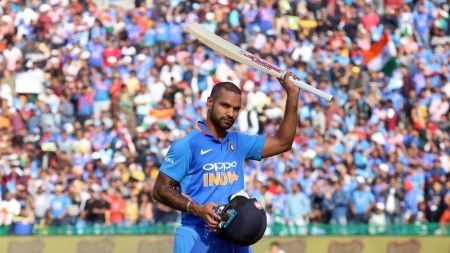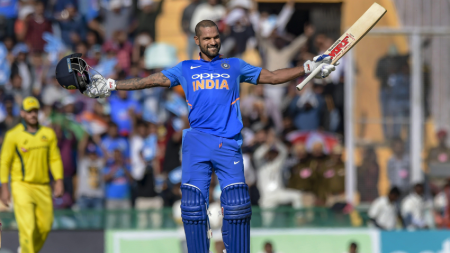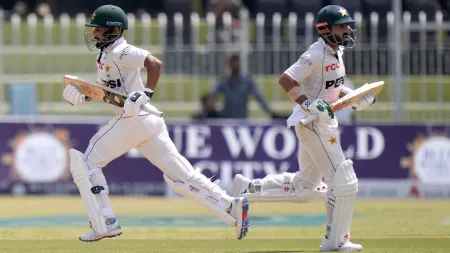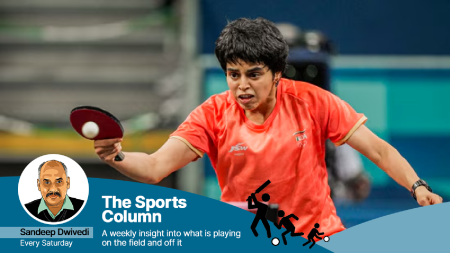Shikhar Dhawan, the ODI batsman, combined the dazzle of Ganguly, the grit of Gambhir and the derring-do of Yuvraj
Shikhar Dhawan would have made one last entry into the diary that he has kept so close to his heart for most of his cricketing journey. The End, he would have scribbled, as he announced his farewell to cricket, a stage that was his life and soul for two decades. The diary keeping habit began during a frustrating period in his career when he couldn’t break into the Indian team. “I wrote small stuff, like whether I was feeling active or sleepy. About how I have to focus despite being bored or sleepy or whatever it was that was causing my dismissal,” he had once told this newspaper.
It became an irresistible habit of his, and one that was symmetrically antithetical to public perceptions. To the masses, he was the moustache-twirling (though the ends were snipped long ago), thigh slapping alpha-male cricketer. He celebrated his runs and milestones with a guffaw that shook the walls and edifices of the stadium, or so was the visual and the imagined aural impression. The enduring memory of Dhawan would be his endearing personality, the joy and exuberance he carried onto his batting and the field, joie de vivre assuming a human form. Seldom has the person in the middle and the person off it seemed the same.

Just before his Test debut, he gifted himself a Hayabusa 1300 cc. After the team’s play, some of his teammates would request (often demand) the keys of the bike. He would readily fling the keys, and to those that ask him about the mileage, he would quip with that playful smile of his: “I don’t even know my batting average, how would you expect me to know the bike’s mileage?” He would linger around with Feroz Shah Kotla groundsmen, like one of their own, sipping endless cups of tea in the December chill.
True to his nature
It didn’t matter whether there was a crowd to watch him or not, he would remain true to his nature. Once he scored a hundred against West Zone in a Duleep Trophy quarter-final in Chennai in 2012. There was barely a soul at the Chepauk, neither was the game televised. But that did not stop him from leaping and punching in the air. At the end of the day, he would delightfully say, “First have to do some rehearsal without the cameras, no?.” He uttered those words so light-heartedly that it was not misconstrued as arrogance. And would casually enquire about the Tamil chartbusters, even admitted that he loved how some of them kept their moustaches.
Assuming a semi-serious face, he would reveal why this hundred was so important to him and the celebrations that followed. “I have squandered many starts in my career, and I know those have blocked my path into international cricket. I had been called rash and reckless. But that’s how I play, when the strokes fly off the middle, people would call me aggressive and stylish. When I edge they immediately criticise my shot making. I have stopped reading newspapers.”
As an afterthought, he says: “Nahin, nahin aapki mein zarooor padga, kal subah,” he said, before peeling into bursts of laughter.
It was sometime before that he found his batting zen. “I realised that more than changing my stance or my technique like I try every year, what I have changed is my way of thinking. Earlier, I used to set targets and try to achieve them, go through emotions whenever I have not got the deserving results. Now, I just try and enjoy my game, do what comes to me naturally and be happy when people walk up to me to say this is what you have got with your efforts,” he would say.
Before that, he kept fiddling with the stance and trigger movement. So much so that his Delhi coach
Vijay Dahiya wondered whether it was a group of Dhawan lookalikes. Story goes that once he briefly flirted with the chest-on guard of Shivnarine Chanderpaul’s. Those were restless days, when he was often a stopgap and was chucked out whenever Delhi played full strength. For much of his early career, he had to compete with Virender Sehwag, Gautam Gambhir and Aakash Chopra.
It was during the dark days, his mind churning with despair but concealed in the radiant smile and mass of tattoos, that he picked his diary-keeping habit. “I was recommended to me that I start writing down how I feel about my batting. So I began putting into words what I had felt while I was playing,” he would say.
He kept his worries to himself. “Despite several setbacks, he always remained cheerful. Even if he would get out for a low score, he would keep the mood in the dressing-room upbeat through his jokes and banter,” former Delhi all-rounder Rajat Bhatia would say.
Even in his farewell note, there is no tinge of bitterness. His career could be read as allegory to fading charms of 50-over cricket. Had the format been as glamorous as it once was, he would have been an undoubted superstar. His career flowered at a time when T20 had consumed the 50 overs cricket, robbed the variegated thrills of it, and Test cricket detached itself further from the abbreviated formats of the game. He tried, and to an extent succeeded, in other formats, but never became a superstar that he could have been. He was as unique a left-handed batsman as any in Indian cricket — he mirrored the dazzle of Sourav Ganguly, the grit of Gautam Gambhir, and the derring-do of Yuvraj Singh. He added a legacy of his own — seldom has batting in ODIs looked an extension of one’s personality than when Dhawan batted. At his best, his batting soothed nerves like a powerful analgesic, instant pain-relief.
And the last entry in his diary could be – “I brought joy to the middle” – before he folds it with a content chuckle, a spontaneous guffaw or a twirl of his moustache.
Disclaimer: The copyright of this article belongs to the original author. Reposting this article is solely for the purpose of information dissemination and does not constitute any investment advice. If there is any infringement, please contact us immediately. We will make corrections or deletions as necessary. Thank you.





